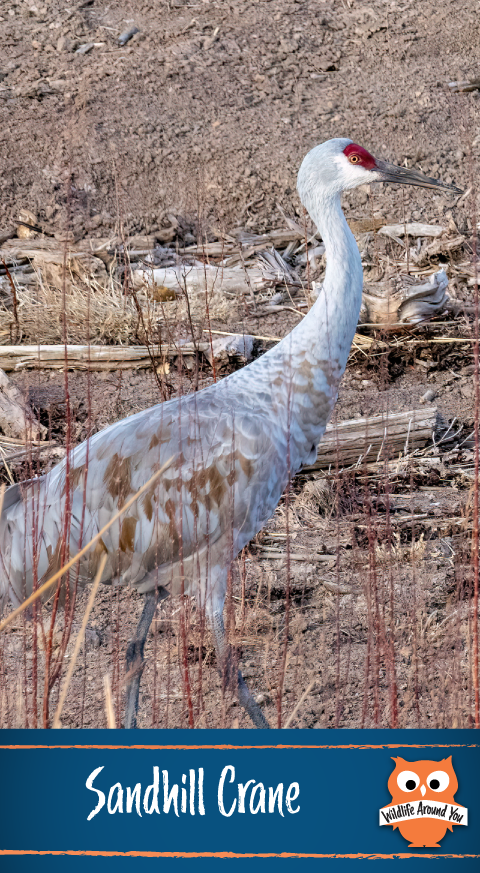Identification
- Sandhill Cranes are large birds, typically standing about 3 to 4 feet tall, with a wingspan of 5 to 7 feet.
- They have gray plumage, a red forehead, and a long, pointed beak. The bulky body tapers into a slender neck; the short tail is covered by drooping feathers that form a “bustle” and the bill is straight and longer than the head.
- Juvenile Sandhill Cranes are lighter in color and have a reddish-brown head.
Habitat
- Sandhill Cranes can be found in a variety of habitats, including wetlands, grasslands, meadows, agricultural fields, and other moist habitats, preferring those with standing water.
- They are found throughout North America, as well as in parts of Asia and Europe.
- They typically migrate to warmer areas in the winter, and return to their breeding grounds in the spring.
Nesting
- Sandhill Cranes build large nests out of the dominant vegetation in the area, usually in shallow water or on the ground. So like cattails, sedges, burr reeds and bulrushes.
- The male and female both contribute to nest-building, which can take several weeks to complete.
- Nests may be 30-40 inches across and 4-6 inches high.
- They may reuse the same nest year after year, or build a new one each year.
Behavior
- Although some start breeding at two years of age, Sandhill Cranes may reach the age of seven before breeding. They mate for life—which can mean two decades or more—and stay with their mates year-round.
- Sandhill Cranes are known for their distinctive calls, which can be heard from a great distance. Sandhill Cranes have long tracheas (windpipes) that coil into the sternum and help the sound develop a lower pitch and harmonics that add richness.
- They are social birds and can often be found in flocks.
- During the breeding season, they perform elaborate courtship dances that involve jumping, running, and flapping their wings.
Offspring
- Sandhill Cranes typically lay 1 to 3 eggs per clutch, and both parents take turns incubating the eggs.
- The eggs hatch after about 30 days, and Sandhill Crane chicks can leave the nest within 8 hours of hatching, and are even capable of swimming.
- Juveniles stick close by their parents for 9 or 10 months after hatching.
- Both parents care for the young, feeding them insects, small animals, and plant material.
- Typically only one nestling survives to fledge.
Predators
- Sandhill Cranes have few natural predators, but eggs and young birds may be preyed upon by raccoons, foxes, and birds of prey.
- In some areas, Sandhill Cranes may be hunted by humans for sport or for their meat.
- Cranes attack aerial predators by leaping into the air and kicking their feet forward. They threaten terrestrial predators by spreading their wings and hissing, eventually resorting to kicking.
Diet
- Sandhill Cranes are omnivorous and eat a variety of foods, including insects, small animals, and plants.
- They feed on land or in shallow marshes where plants grow out of the water, gleaning from the surface and probing with its bill. Its diet is heavy in seeds and cultivated grains, but may also include berries, tubers, small vertebrates, and invertebrates.
- During migration, they may feed in agricultural fields, causing damage to crops.
Fun Facts
- Sandhill Cranes are one of the oldest bird species still in existence, with fossil records dating back more than 2.5 million years.
- They are highly migratory birds, with some populations flying more than 10,000 miles each year.
- Sandhill Cranes are considered a symbol of good luck and longevity in some cultures.
- The oldest Sandhill Crane on record was at least 37 years, 3 months old. Originally banded in Florida in 1982, it was found in Wisconsin in 2019.

